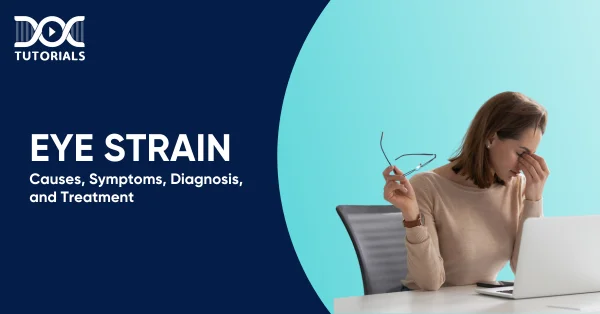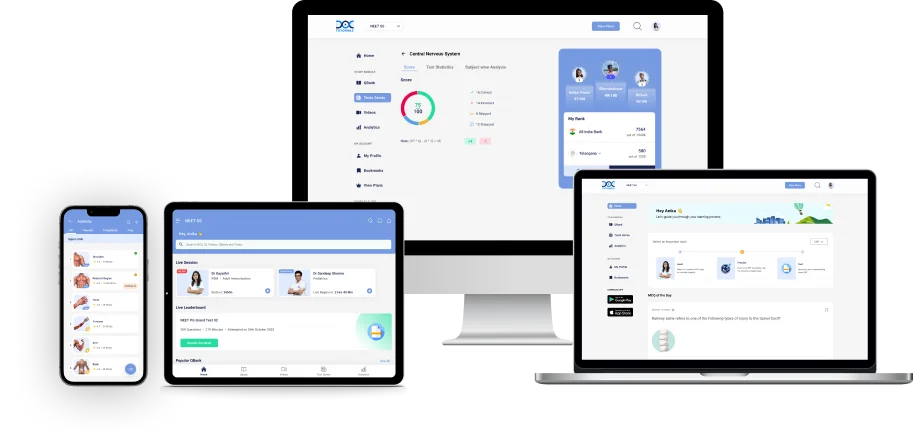Eye Strain | Causes, Symptoms, Diagnosis, and Treatment

In the modern world, where most individuals are glued to their smartphones, computers, and digital devices, eye problems have become common. Eye strain is such one common yet widely underreported condition that arises as a result of extended visual strain.
If you’re preparing for the NEET PG exam, this article will explore the major causes, symptoms, clinical manifestations, and management approaches to manage eye strains in an efficient way. Keep reading for a detailed insight into the concept of eye strains.
What is Eye Strain?
Eye strain, or asthenopia (eye fatigue), is an irritation or fatigue of the eyes induced by prolonged use. For example, the eyes may become strained by reading small fonts or by staring at a computer monitor for several hours. It often happens after long periods of close focus or screen use.
Prolonged use of digital devices has become a prime cause in modern life. In fact, studies reveal that even two-thirds of individuals experience digital eye strain symptoms. Eye strain may result in pain (e.g. blurred vision or headaches), but it is typically a short-term pain.
It could mean that it may be just the eye muscles working too hard. Most individuals get better with bed rest or home treatment.
What are the Causes of Eye Strain?
Concentrated staring without a break may cause the eye muscles to strain and may result in fatigue. Indicatively, low light or high-intensity glare are among some of the factors that can instantly cause discomfort in the eyes. A few of the common causes of eye strain are:
- A prolonged intense concentration (reading, driving, or working on digital displays)
- Operating under dim or poor lighting
- Pre-existing eye problems (such as uncorrected refractive error, including nearsightedness, or farsightedness, or dry eyes)
- Stress, overwork or prolonged tasks without a break
- Environmental conditions such as dry moving air by fans or air-conditioning
An array of tasks that demand intense concentration (like sewing delicate details or long-range driving) may also play a part. Extended screen use, sometimes referred to in newer terms as computer vision syndrome, manifests in a variety of ways.
For example, the American Optometric Association reports that two or more consecutive hours dedicated to the usage of a screen significantly increases the likelihood of strain. Individuals who are predisposed to strain already have uncorrected vision problems or eye muscle imbalances.
What are the Symptoms of Eye Strain?
Common symptoms of eye strain include:
| Category | Symptoms |
| Eye-Related | – Sore, burning, or itchy eyes- Watery or unusually dry eyes- Blurred or double vision- Sensitivity to light- Heavy or tired eyelids |
| Other | – Headaches- Neck, shoulder, or back discomfort- Difficulty concentrating |
Such symptoms tend to build over time in a visual task and are usually resolved with rest. An individual might find that their vision becoming blurred or a slight headache developing after a period of study. Relief is usually quick with over-the-counter (OTC) lubricating drops or just closing the eyes for a few minutes.
Eye strain invariably resolves with simple self-treatment. Nonetheless, in case the discomfort is extreme or chronic, it is essential to take an eye test to exclude alternative causes.
What is the Diagnosis of Eye Strain?
For diagnosis, an eye care professional may start with an evaluation on the symptoms and everyday visual activities. They would inquire about the timing and frequency of symptoms.
An in-depth vision test would be done to test:
- Visual acuity (clarity of vision)
- Eye alignment and coordination
- Refractive errors such as nearsightedness or farsightedness
- Muscle balance and focusing ability
The aim is to detect any underlying eyesight impairments that might be causing eye strain. Depending on the findings, an individual treatment or correction plan is prescribed.
What are the Treatment Options for Eye Strain?
To relieve eye strain, the following treatment options or lifestyle considerations are advised:
- Take Breaks: Give your eyes frequent rest. For example, use the 20-20-20 rule: every 20 minutes, you need to look 20 feet away for 20 seconds.
- Use Lubricating Eye Drops: Artificial tears are used to maintain moisture in the eye and mediate dry-eye symptoms.
- Improve Lighting and Reduce Glare: Room lights need to be indirect and dim. Put desk lamps against the glare, use blinds to prevent overhead glare, and consider an anti-glare screen filter.
- Wear Proper Eyewear: When wearing glasses or contacts, ensure they are the correct prescription for reading or using a computer. Special computer glasses or lens tints and coatings can reduce strain for prolonged screen use.
- Blink More Often. Consciously blinking replenishes tears and refreshes the eyes, counteracting the dry-eye effect of prolonged screen use.
- Adjust Your Workspace. Sit with your monitor about an arm’s length away, with the top of the screen at or slightly below eye level. This head position helps reduce eye drying. Use an adjustable chair and maintain good posture to support your back.
- Switch Focus Periodically. Periodically look at distant objects to relax your eye muscles between close work.
- Improve Air Quality. Use a humidifier and avoid having fans or air conditioner blow directly on your face. Dry air can make eye dryness worse.
- Good Nutrition. A diet rich in omega-3 fatty acids (found in fish oil) may help improve tear quality and relieve dryness.
Most people find these measures immensely beneficial to reduce strain. If eye strain is caused by an underlying condition, treating that condition is key. For instance, renewing an old eyeglass prescription or correcting a vision problem can relieve fatigue.
In other cases, an eye doctor can recommend some vision exercises to enhance eye coordination. In general, the focus is on lowering the workload on the eyes through lifestyle transformations and ergonomic modifications.
FAQs About Eye Strain
- What causes eye strain?
Activities requiring prolonged focus (driving, reading, computer or phone use) can strain the eyes. Poor lighting, glare, uncorrected vision issues, or very dry conditions also contribute.
- How can I relieve eye strain?
Regularly taking breaks and shifting the eye focus might help. Use the 20-20-20 rule, frequent blinking, and lubricating drops. Correct your lighting and posture, and ensure that you have the appropriate glasses to facilitate your activities.
- Do blue-light-blocking glasses help?
The blue light that is emitted by the screen is not a proven cause of eye strain. Such glasses can ease the perceived glare, but they are not necessary. Concentrate on good habits (such as breaks and lighting) instead of special lenses.
- Is eye strain dangerous?
No, it is generally only a passing inconvenience. The simple eye strain does not cause serious damage. However, when symptoms persist, it would be prudent to investigate other potential issues.
- When should I see a doctor?
Schedule a doctor appointment if your eye discomfort is severe, frequent, or accompanied by changes in your vision. An expert will be able to exclude other eye disorders and prescribe any necessary medication or eyewear.
Conclusion
Eye strain is mostly treatable through simple lifestyle interventions. Proper eye habits, such as exposure to proper light, frequent blinking and rest, can eliminate the discomfort of reading or working on the screen endlessly.
As a medical student preventing eye strain should be a priority, as it is a prerequisite for maintaining health and productivity. By understanding the reasons and following the tips listed above, you can stay focused, comfortable, and efficient during intensive studying.
Platforms like DocTutorials offer expert-curated resources to reinforce your knowledge base of clinical concepts such as eye strain not only as a study aid but also in patient care once you are in practice. Join DocTutorials and explore our NEET PG course today!
Latest Blogs
-

NEET SS Exam 2024: Analysis, Key Dates, Counselling
The NEET SS 2024 exam kicked off on March 29, 2025. Over two days and two slots, candidates across 13…
-

NEET PG Registration 2025: An Essential Guide For Exam Prep
The NEET PG registration, which is conducted online, is a crucial step in the exam process. Filling out the NEET…
-

NEET PG Syllabus 2025: A Must-Have Complete Guide for Exam Success
The NEET PG Syllabus acts as one of the foundation stones for aspiring postgraduate medical students like you who are…




